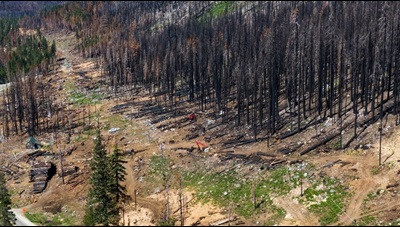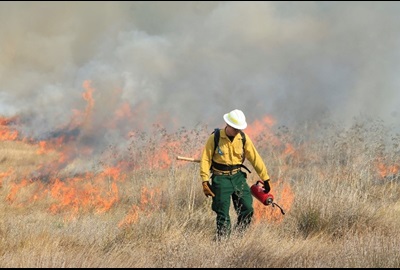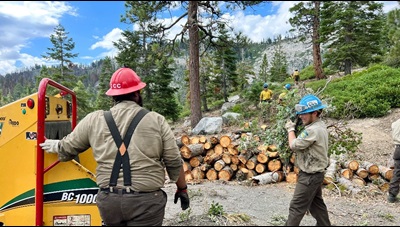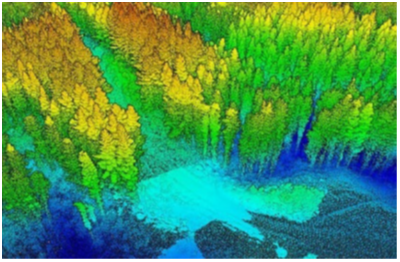Fast-Tracked Fuel Reduction Project Requests
Overview
 California’s invaluable forests and intermingled shrublands, and grasslands harbor abundant wildlife, provide critical water supply, moderate air quality, serve as spiritual and cultural centers for indigenous and local communities, yield unique recreational opportunities, supply timber and offer countless other benefits to urban and rural communities alike. Yet, these ecosystems, and the myriad benefits they provide, face ongoing and increased pressure from conversion, pollution, and disturbances related to changing climate conditions.
California’s invaluable forests and intermingled shrublands, and grasslands harbor abundant wildlife, provide critical water supply, moderate air quality, serve as spiritual and cultural centers for indigenous and local communities, yield unique recreational opportunities, supply timber and offer countless other benefits to urban and rural communities alike. Yet, these ecosystems, and the myriad benefits they provide, face ongoing and increased pressure from conversion, pollution, and disturbances related to changing climate conditions.
The California Natural Resources Agency (CNRA) works to protect, restore, and manage the State’s natural, historical, and cultural resources for current and future generations. Among its core responsibilities in managing forests, shrublands, and grasslands, CNRA provides leadership and guidance in regulatory development and permitting oversight, planning, monitoring, enforcement, fund management, and external relations. Managing long-term programs, projects, and funds, CNRA and its Boards, Departments, and Offices (BDOs) use creative approaches based on science, collaboration, and respect for all the communities and interests involved.
Entrusted with public funds and teeming with expert scientists, engineers, forestry practitioners, and policy makers, CNRA, its BDOs, and interagency partners are actively engaged in managing forested landscapes of the State. Highlighted initiatives led by CNRA, and enacted with CNRA’s BDOs and interagency partners, include the following:
- Timber Regulation and Forest Restoration Program | Flagship program charged with holistic management and regulation of forested landscapes of California, including permitting and oversight of timber harvest, and forest ecosystem health and restoration
- Historic Investments in Climate Action | Multi-billion-dollar investments in capacity building and on-the-ground activities to protect communities and wildlands from the effects of climate change, including rebuilding wildfire resilience
- Cutting the Green Tape| Interdisciplinary and interagency initiative to increase the pace and scale of ecological restoration and stewardship by amending and streamlining various government processes
- Climate and Wildfire Resilience Technology Portfolio | Blend of strategic investments in technology and innovation to further strategic planning and monitoring efforts in support of ecosystem management and climate resilience
- Wildfire and Forest Resilience Task Force | Established in 2021, the Task Force brings together CNRA, its BDOs, interagency partners, Tribes, universities, and the public to coordinate and catalyze actions to address the wildfire crisis facing California
These and other related efforts, described below, have tightly coupled relationships. Staff at CNRA work to coordinate these efforts and ensure that personnel and monetary investments are deployed strategically.
Novel Threats Facing Fire-Adapted Ecosystems: Causes and Consequences
Forests in Focus

California’s nearly 33 million acres of forests represent the state’s largest land-based carbon pool, drawing carbon from the atmosphere and storing it in wood and in forest soils. These forested ecosystems continue to provide intrinsic values and deliver tremendous ecosystem services to Californians and the globe. However, California forests have become a source of carbon emissions due to increasing climate change-induced disturbances, including rising temperatures, extended droughts, and extensive and severe wildfire.
Extreme environmental variability induced by a changing climate and the associated wildfire crises have been compounding for centuries, starting with the genocide of Native American tribes by encroaching settlers and elimination of tribal forest management including cultural fire. With the onset of gold-rush era clear cutting and a legacy of fire exclusion policies across the Western United States, large portions of California’s forested ecosystems have been structurally and functionally altered, particularly with the removal of the natural role wildfire historically played in managing ecosystems. Cascading impacts on wildlife and their habitat, water security, recreational assets, infrastructure, and more have resulted from these legacy actions and policies. Towns, cities, and infrastructure now located alongside or within overly dense forest stands are now more vulnerable to catastrophic wildfire events. Further, these communities and infrastructure can present a danger to wildlands caused by human-ignited wildfire.Beyond Forests: Shrublands and Grasslands Shrublands, including chaparral, cover 32.8 million acres of California, while grasslands constitute 9.9 million acres. These native ecosystems provide a unique mosaic of habitats for locally adapted species, filtering water supply, limiting erosion and landslide potential, mitigating wildfire behavior, and sequestering carbon. While shrublands are dominated by woody plants like forests, grasslands are dominated by grasses and soft-stemmed broad-leafed plants such as forbs with less than 10% of the vegetative cover consisting of shrubs and trees.
California’s shrublands and grasslands have changed dramatically throughout history, from stewardship by Native Americans for medicine, food, and building resources to the colonial introduction of widespread livestock grazing and invasive grassland species that compete with and often entirely displace native fire resilient plants. Evidence demonstrates that shrubland and grassland types in California, such as Southern California and coastal chaparral, are generally burning more frequently than they have historically due to non-native species encroachment comprised of flammable “flashy” fuels. Coupled with conversion of shrublands and grasslands due to urban sprawl and croplands, these ecosystems are becoming increasingly degraded, impairing their ability to prevent erosion and provide clean water, and resulting in increased emissions and reduced carbon storage. On top of historic and ongoing degradation of these ecosystems, the State’s shrubland and grassland systems are experiencing the stress of climate change, particularly climate-driven woody plant encroachment and shifts in annual precipitation.
Extremes in Environmental Variability: Role of Climate Change
California’s forests, shrublands, and grasslands are adapted to wildfire and require wildfire as a natural ecological disturbance to sustain and balance these systems. However, in recent years, changing climate conditions have increased temperatures and prolonged drought conditions, hitting a tipping point with worsening insect infestations, disease, tree mortality, and wildfire outcomes. Over the last two decades, through public and private landownerships, wildfires in California have been increasing in size, severity, and destructive capacity. In the past ten years, California has faced the deadliest and most destructive wildfires in the State’s history. These catastrophic wildfires killed scores of people, destroyed tens of thousands of homes and businesses, and devastated millions of acres of precious habitat and critical watersheds. Further intensifying the effects of climate change, the size and severity of recent wildfires has negatively influenced post-disturbance natural regeneration, threatening millions of acres of natural lands that are at risk of type conversion (land cover permanently converting from forest to non-forest, or shrublands to non-shrublands).
In the coming decades, climate projections show broad agreement that California (as with other Western states) is expected to experience a greater magnitude of climate related disturbance (environmental variability such as extremes in precipitation, wind events, temperatures, and related outcomes including floods, landslides, extreme wildfire behavior, and the like). A fundamental and long-term shift is needed in how forested ecosystems are managed to mitigate and adapt to California’s growing population in a changing climate. While we don’t have complete understanding of how forests will respond in the long-term to a changing climate and related threats, just as with monetary investments, diversifying forest management strategies and building towards healthier landscapes is key to building resilience for tomorrow.
How Can Management Help Solve These Crises
Across forest, shrubland, and grassland ecosystems, a blend of management approaches are needed, including:
- Within communities such as defensible space;
- Around communities such as strategic fuel breaks; and
- Across broad landscapes, restoring watersheds through forest health and resilience treatments such as prescribed grazing and reducing forest stand densities in strategic locations.
However, during extreme wildfire conditions (e.g., dry fuels, high wind events), it is critical to pair vegetation management with home and infrastructure hardening to help ensure the built environment and the public have a fighting chance. When utilized in conjunction with wildfire suppression activities, home hardening and strategically placed fuel breaks, such as those maintained through prescribed herbivory, can help defend threatened communities and natural and cultural resources.
It is important to note that while techniques adopted for the management of forests, such as thinning or fuel breaks in strategic locations help mitigate aspects of a wildfire, intensive and extensive vegetation management in shrublands and grasslands may not confer the same degree of ecosystem benefits or wildfire risk reduction. As shrublands (including chaparral) and grasslands are experiencing high levels of human-caused ignitions and vegetation loss from urban and suburban development, frequent fire and gradual native vegetation loss are on the rise. This is leading to more catastrophic wildfire outcomes and impairing the ecosystems from rebounding and continuing to provide critical water quality, erosion control, wildfire habitat, carbon sequestration, and similar services.
Additional Resources for Reference
- Governor’s Wildfire and Forest Resilience Task Force
- Fire and Resource Assessment Program | Assessment CAL FIRE conducts periodic assessments to align the state mandates for natural resource inventories and strategies with the federal government's objective to increase reliance on state programs for determining funding priorities. These assessments provide critical data that is used to inform decision-making at both the state and federal levels, and ensure that resources are allocated to the areas that need them most.
- 2022 Scoping Plan Update and Appendices |The California Air Resources Board 2022 Scoping Plan for Achieving Carbon Neutrality lays out a path to achieve targets for carbon neutrality and reduce anthropogenic greenhouse gas (GHG) emissions by 85 percent below 1990 levels no later than 2045, as directed by Assembly Bill 1279. The actions and outcomes in the plan include addressing increased action on natural and working lands to reduce emissions and sequester carbon.
 For decades, State and federal agencies have invested significant resources in support of programs and projects to protect and restore forested ecosystems confronted with degradation, such as land conversion and pollution. While forest ecosystem conditions vary greatly depending on forest type, location, and circumstance, with some forest stands in healthy condition and others not, all forests face new and increasing threats with a changing climate. The State, federal agencies, and other partners are drastically ramping up action to preserve intact and healthy forests and reverse negative trends in more vulnerable forests.
For decades, State and federal agencies have invested significant resources in support of programs and projects to protect and restore forested ecosystems confronted with degradation, such as land conversion and pollution. While forest ecosystem conditions vary greatly depending on forest type, location, and circumstance, with some forest stands in healthy condition and others not, all forests face new and increasing threats with a changing climate. The State, federal agencies, and other partners are drastically ramping up action to preserve intact and healthy forests and reverse negative trends in more vulnerable forests.
The Newsom Administration and the California Legislature have set bold targets, provisioned historic resources, and enacted legislative mandates to help rapidly scale up on-the-ground action, build workforce and infrastructure capacity, and innovate using data and technology. This includes work to ensure policy and regulation meet the urgent needs of California’s communities and wildlands. Below are some featured efforts the State has taken on to protect forested ecosystems of California, for all Californians.

Nature Based Solutions Climate Targets
In April 2024, building upon the 2022 California Air Resources Board Scoping Plan Update, the Newson Administration established new bold targets for natural and working lands across the State’s ecosystems and communities, for more resilient and healthy ecosystems and durable and diversified carbon stocks. Among the targets is a call to ramp up management action by 2045 to address:
- Areas at high risk of wildfire including forests, shrublands, and grasslands- totaling 33.5 million acres managed to reduce wildfire risk, mostly through beneficial fire and other fuel reduction activities including thinning, prescribed herbivory, and invasive species removal
- Forests- totaling 11.9 million acres of forest managed for biodiversity protection, carbon storage, and water supply protection including restoration, working forest conservation, old growth conservation, and oak woodland reestablishment.
The targets reflect an “all hands-all lands” approach, that will require broad public and private participation. For its part, CNRA is working aggressively with its BDOs and interagency partners, integrating programs, projects, and funds towards meeting these new ambitious targets by 2045.

To read more, see the full document on the Nature Based-Solutions Climate Targets.
For more information on the targets in the context of related strategies, please visit CNRA’s Climate Team page on Expanding Nature-Based Solutions.
Wildfire Resilience Funding
California has undertaken an urgent paradigm shift to address the growing wildfire crisis. Given the frequency, severity, scale, and destructive capacity of recent wildfires, preventative wildfire resilience efforts are essential. This includes deployment of prescribed burns and mechanical thinning in socially and ecologically appropriate settings, and strategic fuel breaks and home hardening to alter a fire’s behavior and help both wildlands and communities survive wildfires.

Since 2021, California has dramatically scaled wildfire and forest resilience investments from $200 million annually to provisioning nearly $2.5 billion covering multiple years for wildfire resilience action in California’s watersheds, wildlands, and communities. Nearly $2.2 billion for multi-year projects has been committed to projects to date. The State has correspondingly shifted business practices to put resources into on-the-ground projects, capacity building, workforce development, and more. This, atop the recent passage of the Climate Bond- Proposition 4 (see next section), brings the total investment earmarked for wildfire and climate resilience to be deployed this decade to more than $4 billion.
California’s 2023 Wildfire Resilience Program Budget Report (Coming Soon)
California’s 2022 Wildfire Resilience Program Budget Report
California’s 2021 Wildfire Resilience Program Budget Report
Climate Bond
Californians passed Proposition 4, the first-ever climate bond to go before California voters. The proposition provides $10 billion in bond funds for critical wildfire, flood protection, and other climate resilience projects around the state, including $1.5 billion for wildfire resilience. This funding will enable agencies to improve landscape health and resilience and protect communities from wildfire risks through programs such as the Regional Forest and Fire Capacity Program. The funding also includes $50 million for long-term capital infrastructure projects that utilize wildfire mitigation waste for non-combustible uses.

In addition to funding wildfire resilience, $1.2 billion will be used to protect natural lands and preserve biodiversity, with $870 million directed to the Wildlife Conservation Board to help the state to meet its goal to protect 30% of lands by 2030. The approval of Proposition 4 is a major advancement for California’s efforts to increase the pace and scale of wildfire and landscape resilience treatments, adapt to a changing climate, and reach goals set in the California’s Wildfire and Forest Resilience Action Plan.
Legislative Mandates
Along with setting aggressive management targets and provisioning new financial resources, the State Legislature has enacted a raft of legislative mandates to ensure State agencies meet the targets, including implementing projects and accounting for progress made.
Among the mandates CNRA, its BDOs, and agency partners must address, are the following:
- SB 901 (2018) | Provisioned $200 million per year from the Greenhouse Gas Reduction Fund for forest health and wildfire prevention projects. Further, the legislation defined new Forest Practice Rules exemptions for fuel reduction and forest management projects and required CAL FIRE to develop new regulations for defensible space in very high fire hazard severity zones. Additionally, required reporting includes measuring the carbon impact from wildfire and forest management activities.
- SB 456 (2021) Established the Governor’s Wildfire and Forest Resilience Task Force as a coordinating and catalyzing force across public and private entities to mitigate the wildfire crisis facing fire prone landscapes of California. This included the creation and maintenance of an Action Plan that helps support and encourage the actions of myriad projects, programs and partners.
- AB 1757 (2022) | Requires CNRA, by January 1, 2024, in collaboration with CARB, CalEPA, the California Department of Food and Agriculture (CDFA), and an expert advisory committee, to set targets for natural carbon sequestration and nature-based climate solutions (NBS) for 2030, 2038, and 2045, which must be integrated into the Scoping Plan and other State policies. In partial fulfillment of the legislation, CARB and CNRA are required to work together to track, analyze, and report on the NBS climate targets and their effects on carbon, other benefits, and vulnerable communities across all of California.
California forests are central to the state’s strategies to protect biodiversity, the ensure the provision of critical water supply, and mitigate the effects of climate change to make our communities, watersheds, and wildlife habitats resilient. On several fronts, CNRA is working to accelerate efforts to restore forest health and resilience in California’s forests and interspersed shrublands and grasslands. Programs and initiatives below are featured efforts led by CNRA.
Timber Regulation and Forest Restoration Program
Assembly Bill 1492 (2012) established the Timber Regulation and Forest Restoration Fund and Program which employs 223 interagency program staff to provide permitting and regulatory oversight of commercial timber harvest, as well as protection and restoration of the State’s forests across all landownerships. In partial fulfillment of this mandate, CNRA must develop and implement a monitoring protocol to evaluate the impact and effectiveness of management occurring across the State’s forested watersheds.
The Timber Regulation and Forest Restoration Program and its personnel are instrumental in meeting our targets and actions for climate, biodiversity, and water resilience. As referenced in the section above, with the establishment of new Nature Based-Solutions Climate Targets, California has set the bar high to meet the level of action needed to sustain California’s natural and working lands, including forested landscapes.
Read more on the Program initiatives by clicking here.
As demands and challenges mount in fire-adapted landscapes of California, and interagency goals and targets are set to address the Administration’s priorities and the needs of the public, CNRA, interagency partners, universities, industry, NGO’s and the public have joined forces. In a response commensurate to the challenge, Governor Gavin Newsom created the California Wildfire & Forest Resilience Task Force, bringing together an unprecedented coalition of personnel and resources for preventing catastrophic wildfires to create safer communities and healthier, more sustainable natural environments. The Governor’s Task Force is a coordinating and catalyzing body that works to bring partner priorities forward and jointly tackle the novel and complex challenges facing the State.
CNRA’s forestry and landscape resilience program activities are coordinated with the Task Force, and CNRA works with the broader partnership to work strategically together. Among the key efforts CNRA staff actively engage in and promote, are the following highlighted efforts:
- “Cutting the Green Tape” initiatives to scale forest health and restoration action by reducing administrative delays
- Building on partners efforts to deliver data and science for strategic planning and monitoring needed to save lives and natural resource assets
- Promoting workforce development efforts to ensure a long-term workforce is in place to deliver on wide-ranging forest health and wildfire resilience needs
- Supporting wood utilization strategies to manage the excess of waste woody biomass and help meet our state’s sustainable forest management goals.
- Expanding the use of beneficial fire to sustainably and effectively manage large fire-adapted landscapes into the future.
Read more about the Task Force and its wide-ranging partnerships and initiatives here.
As California works toward ambitious wildfire and landscape resilience goals, transparency is critical to success. Using science and data to track the health of our fire-adapted ecosystems, CNRA is leading a long-term statewide forest ecosystem monitoring and assessment initiative. This effort will greatly improve understanding as to how forest management and harvest practices impact ecosystem health. By integrating interagency data and remote sensing from state and federal resource programs, CNRA is establishing a spatially explicit, consistent approach to track ecosystem conditions over time at a watershed scale. Along with other state efforts to monitoring fire-adapted landscapes, CNRA’s assessments will allow the State and federal agencies to evaluate how their programs have affected entire landscapes.
Remote Sensing for Public Safety & Natural Resource Management

The investment CNRA has made will revolutionize the way the State uses the latest technology to fight the negative impacts of climate change and catastrophic wildfire. The data and insights gained from these investments will enable California to be on its front foot in understanding the impact and effectiveness of the state’s multibillion dollar wildfire resilience investments. CNRA is taking a one-time investment and creating an enduring program of work for the operational use of multiple agencies and the public.
Read more about the State’s investments in monitoring here.
Check here to see select events and news CNRA is engaged in and learn more about past events and news.
Fresh LiDAR Data Collection | Update
With the substantial dedication of funds by the California State Legislature, >30,000 square miles of LiDAR covering much of California’s Sierra Nevada are now freely available! These data, collected in 2022 between Lassen National Park to south of Bakersfield, were acquired with the financial contributions of the US Geological Survey, California Natural Resources Agency, UC San Diego ALERTCalifornia, Natural Resources Conservation Service, and US Forest Service.
- Data will be used by emergency managers, natural resource managers, and others, to protect communities and wildlands from the increasing effects of climate change, including wildfire planning, response, and recovery.
- Partners will develop publicly available derived products that can be used to support ecosystem planning and monitoring efforts.
More data is coming. CNRA and partners have invested in over 40 million acres of fresh LiDAR collections covering gaps and refreshing older collections across much of the State's grasslands, shrublands, and forests. Updates will be posted here.
To download the Digital Terrain Models: https://lnkd.in/gsNt2-eH
To download the point clouds: https://lnkd.in/gCpTiZ_M
 Lisa serves as Deputy Secretary for Forest and Wildfire Resilience, leading the Agency’s initiatives to improve the health of California’s forests and landscapes while building resilience to wildfire. She also serves as the Agency’s lead in implementing California’s Wildfire and Forest Resilience Action Plan and aligning policies, programs and investments to help achieve the Action Plan’s goals. Prior to being appointed to the role in September 2023, Lisa served as Senior Advisor for Strategic Communications at the Agency from 2021 to 2023 and as Deputy Secretary for Communications from 2017 to 2021. Before joining the Agency, Lisa served as Director of Communications for the Association of California Water Agencies for five years and held various other positions at that organization. She holds a bachelor's degree in journalism and Spanish from the University of Wisconsin-Milwaukee and started her career as a reporter for the Milwaukee Sentinel.
Lisa serves as Deputy Secretary for Forest and Wildfire Resilience, leading the Agency’s initiatives to improve the health of California’s forests and landscapes while building resilience to wildfire. She also serves as the Agency’s lead in implementing California’s Wildfire and Forest Resilience Action Plan and aligning policies, programs and investments to help achieve the Action Plan’s goals. Prior to being appointed to the role in September 2023, Lisa served as Senior Advisor for Strategic Communications at the Agency from 2021 to 2023 and as Deputy Secretary for Communications from 2017 to 2021. Before joining the Agency, Lisa served as Director of Communications for the Association of California Water Agencies for five years and held various other positions at that organization. She holds a bachelor's degree in journalism and Spanish from the University of Wisconsin-Milwaukee and started her career as a reporter for the Milwaukee Sentinel.
Loretta Moreno, Environmental Program Manager, Forest and Wildfire Resilience

Loretta is the Environmental Program Manager leading the Timber Regulation and Forest Restoration Program at CNRA. She advises the Deputy Secretary for Forests and Wildfire on science and policy matters. Loretta’s expertise centers on natural resource management principally within the forest sector with a current focus on wildfire resilience in California. She is leading development of a statewide monitoring and evaluation system as a part of tracking the effectiveness of the state's multi-billion-dollar wildfire and climate resiliency investments. Further she works with forestry program leadership implementing the Timber Regulation and Forest Restoration Program, including grant disbursement, permitting, enforcement, and science development. She coordinates interagency and intergovernmental science and policy initiatives. She formerly co-chaired the Board of Forestry's Effectiveness Monitoring Committee as well as the Monitoring, Reporting and Assessment and Regulations Working Groups of the Governor's Wildfire and Forest Resilience Task Force.
Loretta has worked internationally residing in Austria, Germany and Argentina as a researcher, Fulbright Scholar, and consultant focused on forest conservation, ecosystem services and multi-stakeholder forest policy and planning efforts focused on Argentina and Paraguay. In former roles as a land use planner for the Counties of Santa Barbara, Ventura, and Santa Cruz in California, she analyzed rural development proposals across ranch and farmland in the wildland interface, and was successful in obtaining Board adoption of a suite of land use ordinances she authored to regulate the cannabis industry. Loretta holds a bachelor's degree in Environmental Studies from UC Santa Barbara and a Master of Science degree in Resource Conservation from the University of Montana.
Contact: Loretta.Moreno@resources.ca.gov




